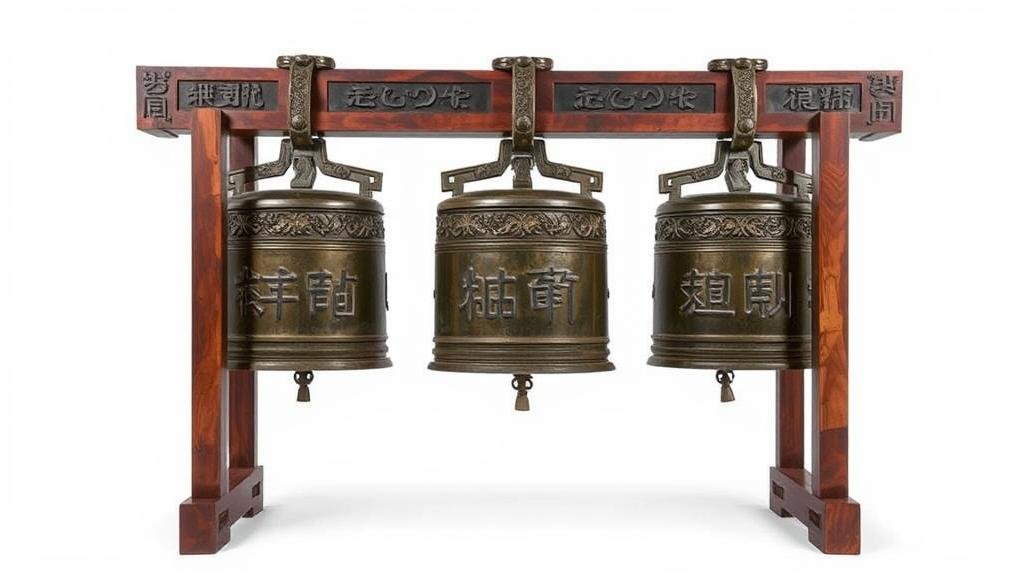Exploring the enigma of the “Rongcheng Bronze Bells,” musical instruments with unexplained tonal properties.
Exploring the Enigma of the Rongcheng Bronze Bells
The Rongcheng Bronze Bells, a remarkable group of ancient musical instruments, are a testament to the sophisticated craftsmanship of early Chinese civilization. Dating back to the Western Zhou Dynasty (c. 1046-771 BCE), these bronze bells have intrigued historians, musicians, and researchers due to their unique tonal properties that remain unexplained even after extensive studies. This article delves into the history, characteristics, and significance of the Rongcheng Bronze Bells, shedding light on their mysterious appeal.
A Historical Overview
The Rongcheng Bronze Bells were excavated in the 1970s from a burial site in Rongcheng, Shandong Province, China. This area, known for its rich archaeological history, has provided significant insights into the culture and practices of the time. Historians believe these bells were used not only as musical instruments but also played an essential role in rituals and ceremonies, signifying status and power.
These bells, often referred to as zhong, were typically cast in sets, which allowed for a harmonic array when played together. set unearthed in Rongcheng comprises 65 bells, showcasing various sizes and elaborate decorations that reflect the artistry of the era.
Unique Tonal Properties
One of the most intriguing aspects of the Rongcheng Bronze Bells is their tonal quality. Unlike other bronze bells from the same period, which produce a more straightforward, metallic sound, the Rongcheng bells exhibit a complexity of harmonics and overtones. This has led researchers to question the methods used in their fabrication.
Studies have shown that the bells possess a distinct tuning system, with well-defined frequencies. For example, a bell can resonate not only at its fundamental frequency but also produce several higher harmonics that create a rich sound palette. In many cases, the bells have been shown to create a just intonation harmony, where the frequencies relate to one another in whole number ratios, similar to the musical scales recognized in various cultures.
The Mysteries Behind Their Creation
The construction technique of the Rongcheng Bronze Bells remains something of a mystery. Current understanding suggests that the bells were made using a lost-wax casting method, which allows for intricate designs and precise shaping. Despite this knowledge, how the craftsmen achieved such consistent tonal quality is less clear.
- The alloy composition may play a critical role; analyses indicate that copper was the primary material, but the percentage of tin and other elements could influence the sound.
- The wall thickness and internal structure of each bell’s body, which vary significantly from bell to bell, likely contribute to the diverse tonal characteristics.
- Researchers have also postulated that the bells might have been subjected to specific finishing techniques that are not yet well understood.
Real-World Applications and Cultural Significance
Beyond their historical significance, the Rongcheng Bronze Bells have implications in contemporary music and sound studies. Modern musicians and composers have explored the unique tones in new compositions, integrating their sound into orchestral performances and modern interpretations of ancient music.
Culturally, these bells serve as a connection to Chinas rich heritage, often featured in museums and cultural exhibitions. Their presence in educational settings promotes interest in ancient Chinese culture and the development of musical instruments throughout history.
Conclusion: Understanding the Enigma
The Rongcheng Bronze Bells represent a fascinating intersection of history, music, and craftsmanship. r unexplained tonal properties not only challenge our understanding of ancient musical technology but also enhance our appreciation for the cultural significance of music in human society. As research continues, these bells may reveal more secrets of their composition and use, enriching our insight into the sophisticated civilization that created them.
To appreciate the Rongcheng Bronze Bells fully, one should consider visiting museums housing these artifacts or participating in workshops that explore ancient musical techniques. Engaging with this rich history can foster a deeper understanding of both the past and its ongoing influence on contemporary culture.



